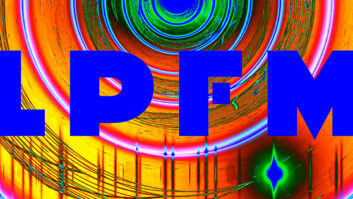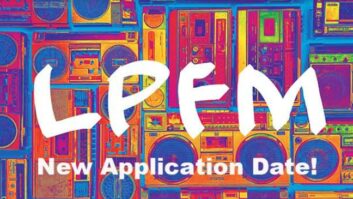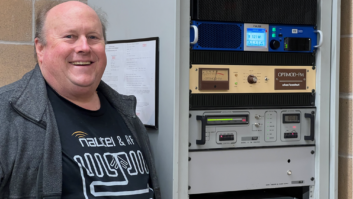WASHINGTON This is the third in a series of articles sampling public comments filed with the FCC in the proceeding to develop final authorization rules for IBOC. Here we excerpt observations about digital recording, AM nighttime skywave service, digital LPFM and data applications.
Microsoft Corp. wrote:
“(W)e specifically encourage the commission to promote the public interest by allowing multicasting and permitting multiple datacasting transports in digital radio signals. …
“Microsoft believes that consumers will be encouraged to transition to DAB if the service offers a greater variety of content than is currently available, both via multicasts of audio streams and via a range of datacasting systems. …
“(T)o enhance multicasting options, the commission should afford broadcasters the flexibility to assign data rates between main and supplemental audio services as appropriate.
“This will give broadcasters the freedom to develop and deploy a range of digital audio services and to adapt those services in response to consumer interest and demand. In addition, the commission should permit the deployment of alternative audio codecs (in addition to Ibiquity’s HD Radio “HDC” codec) for the transmission of supplemental audio services.
“Microsoft further agrees that the commission generally should ‘adopt a flexible policy permitting radio stations to produce and distribute any and all types of datacasting services.’ The adoption of the Ibiquity IBOC transmission and coding architecture for digital audio service does not necessitate adoption of Ibiquity’s digital datacasting architecture, which is still early in development, as an exclusive datacasting standard.”
Public Knowledge, Consumers Union and Consumer Federation of America wrote:
“The Consumer Group Coalition supports the commission’s goal of promoting digital audio broadcasting and believes that attractive DAB services can expand the radio marketplace. Precisely because we support this goal, we argue here that the commission must forbear from imposing copy-protection/content-protection technologies on free over-the-air radio broadcasting and/or on consumer devices built to receive such broadcasts.
“There is no case for saddling digital radio broadcasting with technological restrictions. Furthermore, unnecessary restrictions on DAB technologies will harm the development of innovative DAB products and delay consumer adoption of the technology.
“Although the Consumer Group Coalition respects the commission’s desire to conduct a preliminary investigation of any possible problems associated with DAB and copyright infringement, we argue here that there is no evidence that radio broadcasts are a significant source of infringement. Nor is there evidence that DAB poses any threat to the music industry distribution model. Thus, there is no support for the claim that DAB presents a problem requiring a copy-protection technology mandate, or any content-related technology mandate. …
“The RIAA request for regulation seeks what would effectively be a ban on otherwise legal devices and lawful home recording. As such, this request centers on copyright law and policy, which are beyond the jurisdiction of the commission. To put the matter plainly, the commission has no authority to halt activities that Congress and the courts have established as lawful. Nor does the commission have the jurisdiction to mandate that copy controls be built into DAB devices.
“Properly, this proceeding should focus on digital audio broadcast standards and development; it should not be diverted by misconceived fears of copyright infringement.”
Leonard Kahn, president of Kahn Communications Inc., wrote:
“It is the opinion of the undersigned that this decade-long Rulemaking as it pertains to AM broadcasting should be expeditiously terminated and the commission should permit the awesome power of free competition to complete the job. …
“In these dire days since 9/11, AM radio is the natural mass media system to spread the word of attacks as well as provide the public storm warnings, tidal waves, etc., whenever and wherever such warnings are required. The warning system cannot be inoperable at night, nor can the protected areas be limited to a few miles from New York or L.A., the system must cover all of America.
“Restricting such a vital modernization program to the efforts of just one commercial firm, especially one with an 11-year record of failure to demonstrate nighttime service, is clearly not in the public interest as lives are literally at stake.
“The basic conclusion of this submission is that the FCC should immediately issue an order permitting all AM stations to implement any form of improvement they believe will permit them to better compete with FM, with a single limitation, that said improvements do not create additional interference to other licensees.
“Without the commission seriously considering a single competitive IBOC system, the commission has encouraged AM broadcasters and radio receiver manufacturers to adopt the patented IBOC system “under investigation” (IBOC-ui), that has only been tested on a handful of stations, (only 30 AM stations, some of which have turned the system off after a few days of operation), all of these stations cannot work after sundown and all of them create enormous co- and adjacent channel interference during the day. …
“KCI has commitments with a number of public-spirited broadcasters to accept Cam-D equipment temporarily absent the high fidelity (8 to 15 kHz extended audio response) so that they and the listeners they serve do not have to wait for the development of a new integrated circuit which, at best, will take 8 to 10 months to get into full production. This will permit the mass production of 8 kHz limited radios with 10 data channels; three of the channels will be devoted to homeland security service, and the remaining 7 channels for scrolling news, road conditions, identification of the station and the name of the music being played, etc. …
“All of this service will be confined to less than the present bandwidth allocated to AM stations, as is true of the fully implemented high-fidelity Cam-D System. The name of this new AM system will be PTA-Cam-D System which stands (optimistically) for Pre-Type Approved Cam-D System.”
Ibiquity Digital Corp. wrote:
“JVC currently is manufacturing an integrated HD Radio auto receiver that will be offered for sale in the next few weeks. Onkyo Corp. will introduce this fall an HD Radio home receiver.
“The Kenwood and Panasonic receivers currently are available nationwide from Crutchfield Corp. a large catalog and Internet retailer, as well as from a variety of regional and local retailers in markets currently served by HD Radio broadcasts. Visteon Corp. has announced its intention to launch an Original Equipment Manufacturer automobile receiver for a 2005 model year vehicle. …
“The introduction of AM IBOC at night will not eliminate either groundwave or skywave analog broadcasts. (Ibiquity) tests indicated that there is a potential for an impact to groundwave analog service outside a station’s primary coverage area; however, this should not have a significant impact on the majority of a station’s listeners. The potential impact on analog skywave service is somewhat harder to predict due to the variable nature of skywave service. The tests indicate that nighttime AM IBOC may reduce the availability of the analog skywave signal but it will not eliminate the service. …
“Ibiquity has licensed every entity that has sought a license to manufacture a product incorporating HD Radio technology. … Based on Ibiquity’s existing licensing process, it would be extraordinary and unnecessary for the commission to take any action on this topic. …
“Ibiquity agrees with the commission’s concern that the digital signal for stations with low analog power may fall below the noise floor. Particularly in areas with terrain obstructions or high noise levels, the extremely low power of the digital signal may limit digital coverage.
“Ibiquity recommends that the commission implement procedures to authorize digital operations at levels exceeding 20 dB below the analog signal where needed to overcome coverage limitations. Any increase in digital power levels, however, may raise concerns about the impact on adjacent channel stations.
“Because there has been insufficient field work completed on higher digital power levels and any potential increase in adjacent channel interference, Ibiquity believes it would be difficult for the commission to establish a minimum power level for the digital signal at this time. Instead, Ibiquity recommends that the commission allow stations to adopt higher digital power levels upon an adequate showing that the proposed power level will not cause incremental harmful interference to adjacent channel operations.
“This will allow the commission to assess geographic separation, terrain and other factors that may decrease concerns about adjacent channel interference. … Ibiquity also recommends that these authorizations be implemented as part of the station license rather than as experimental or special temporary authorizations. …
“LPFM stations should have the option to convert their operations to digital broadcasts.
HD Radio system equipment can operate at the power levels authorized for LPFM service. In the case of 10-watt stations, however, the extremely low power level of those stations may make digital broadcasts infeasible. …
“In the case of a 100-watt LPFM station, it is more likely that the digital signal will be recovered by a receiver. Because these LPFM stations are required to comply with the commission’s adjacent-channel interference restrictions, the introduction of digital broadcasts by these stations should not create harmful new interference.”












